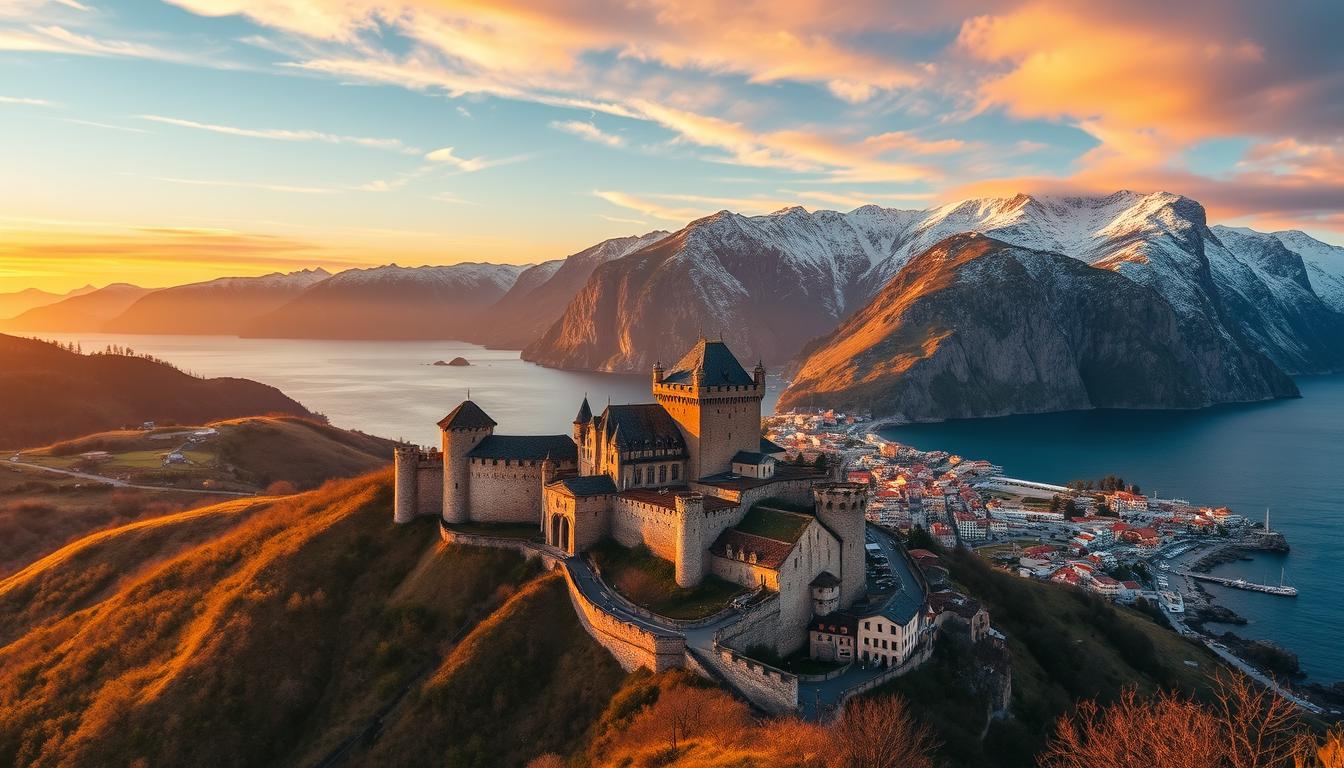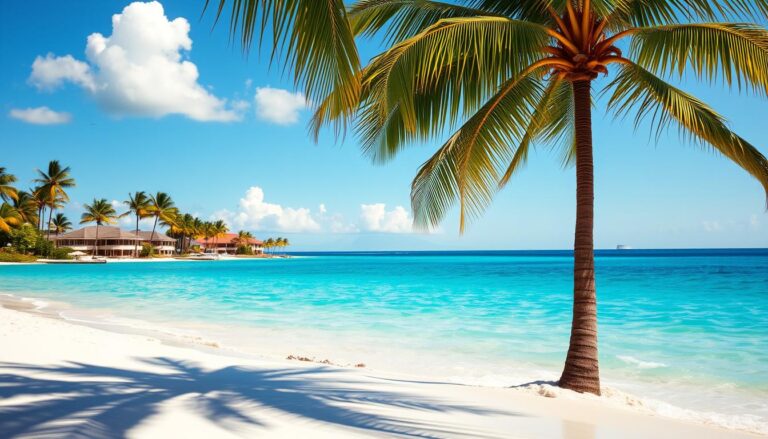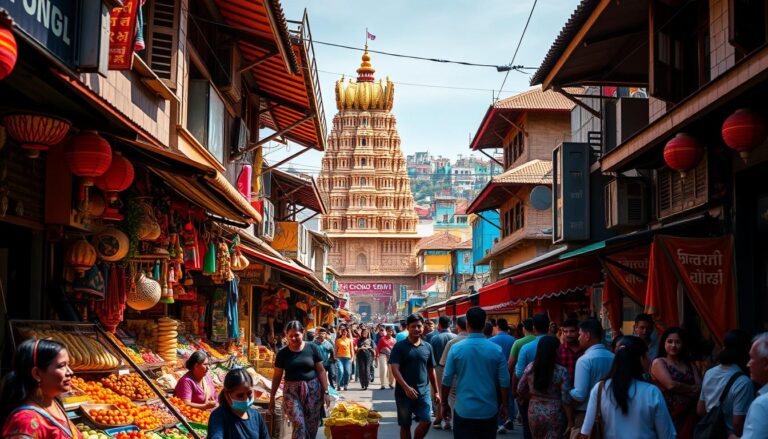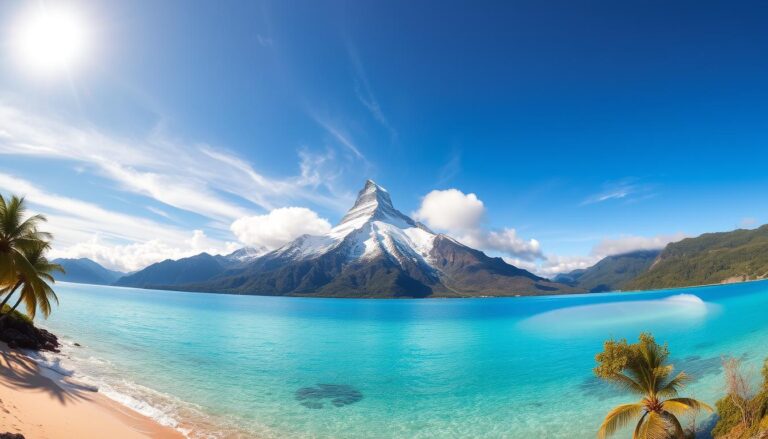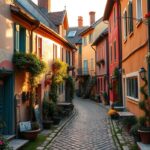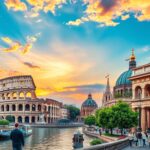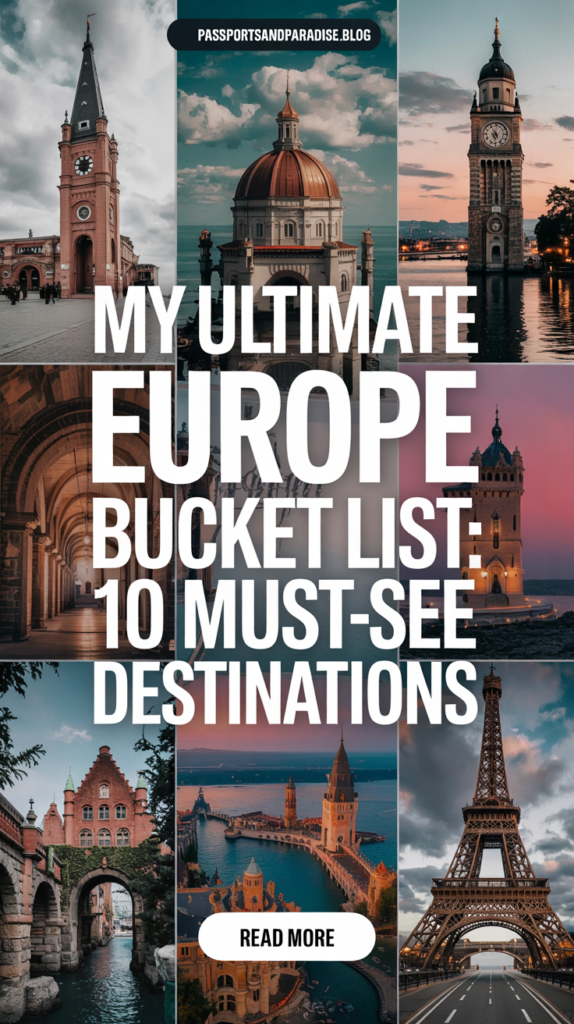
There’s something magical about packing a suitcase and stepping into the unknown. Whether it’s sipping wine in Porto or chasing the Northern Lights in Norway, every journey leaves a mark on your soul. I’ve spent years curating my must-see destinations, blending iconic landmarks with hidden gems—just like the experts at Condé Nast Traveler.
From the turquoise waters of Croatia’s Dalmatian Coast to the cozy hygge cafes of Copenhagen, this list is for dreamers and doers. It balances first-time adventures with spots worth revisiting—because some places just get better with time.
Ready to explore? Let’s dive into the experiences that make travel unforgettable. And don’t worry—I’ll share practical tips later to help you plan like a pro.
Why Europe Deserves a Spot on Your Bucket List
Picture swapping ski boots for flip-flops in the same week—that’s the magic of this region. With 50+ countries crammed into a space smaller than Texas, you’ll find glaciers, vineyards, and everything in between. It’s a bucket-list-worthy corner of the world where high-speed trains zip you from Parisian cafés to Swiss Alps in hours.
Want contrast? Try winter nights at Transylvania’s Ice Hotel followed by summer hikes in Greece’s Santorini caldera. Or chase Portugal’s 100-foot Nazaré waves by morning and sip port in Porto’s cellars by sunset. The options are dizzying.
Here’s why it’s unforgettable:
- Easy multi-country hops: Ferry from Croatia’s islands to Italy’s Amalfi Coast or ride the Glacier Express through the Alps.
- Seasonal whiplash: Ski Andorra’s slopes in March, then sunbathe on Cyprus’ beaches by April.
- Pinch-me moments: Skinny-dip under Sweden’s midnight sun or hear Andrea Bocelli sing in Venice’s piazzas.
Best part? You’ll never run out of new angles. First trip: history in Rome’s Colosseum. Next visit: truffle hunting in Umbria. Adventure? Try Greenland’s Arctic glamping. This place rewards repeat offenders.
Sipping Port Wine in Porto, Portugal
Forget postcards; Porto’s charm lies in its unapologetic authenticity. This city doesn’t glitter—it hums with laundry strung between pastel buildings and the clink of glasses in dimly lit adegas. Lisbon might be the star, but Porto? It’s the backstage pass to Portugal’s soul.
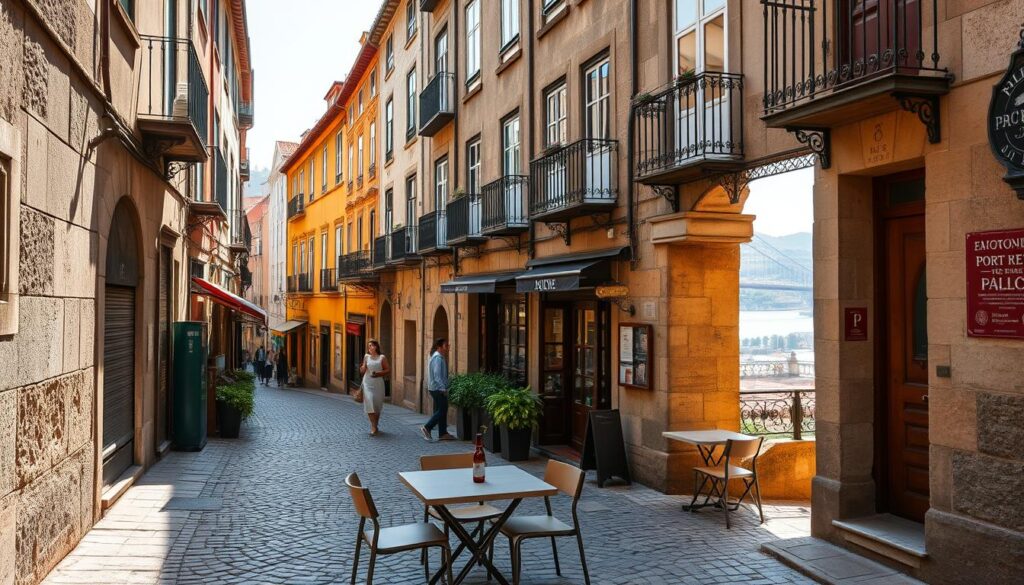
Old-World Charm and Cobbled Streets
Wander Ribeira’s labyrinthine alleys, where azulejo tiles tell centuries-old stories. The Dom Luís Bridge offers sunset views so sharp, you’ll forget to blink. My favorite detour? The 15th-century Franciscan Monastery—its gilded carvings whisper secrets if you listen closely.
Why Porto Beats Lisbon (For Me)
Lisbon dazzles; Porto lures. Here, port wine isn’t just a drink—it’s a way of life. At Sandeman’s cellars, I learned Ferreira ages 21,000 liters per barrel. Insider tip: Pair tawny wine with queijo da Serra cheese. The nutty flavors? Pure alchemy.
Prefer adventure? Kayak through Douro Valley’s terraced vineyards—a UNESCO site where grapes practically drip into the river. For coastal escapes, Aethos Ericeira’s design-forward rooms blend surf culture with luxury. Porto doesn’t just check boxes; it scribbles outside them.
Riding the Venice Simplon-Orient-Express
Time bends differently aboard the Venice Simplon-Orient-Express—where polished mahogany and champagne flutes replace mundane commutes. This train isn’t about getting somewhere; it’s about savoring every sway between Istanbul and Paris. Think Agatha Christie novels, but with Wi-Fi and fewer murder mysteries.
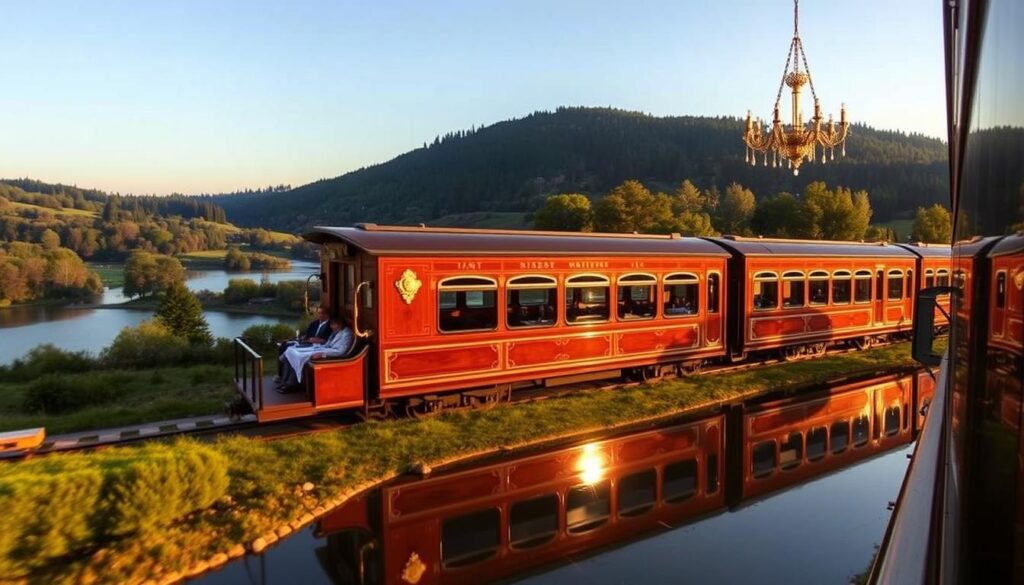
From Istanbul to Paris in Vintage Luxury
The Grand Bazaar’s spice stalls fade as you step into your cabin—a jewel box of Art Deco details. Lalique glass panels glow under brass sconces, and your bed? Folded into plush velvet by a steward who probably moonlights as a time traveler. Dinner is served in the Côte d’Azur car, where scallops arrive on china thinner than your patience at airport security.
Pro tip: Splurge on a Grand Suite if midnight piano bars are your thing. The private lounge lets you host impromptu Gatsby parties while Hungary’s countryside blurs past.
Bazaars, Budapest, and Midnight Piano Bars
Budapest steals the show at dawn. Skip the thermal baths’ crowds (they’re overrated before coffee) and head straight to Fisherman’s Bastion. Sunrise here isn’t a view—it’s a thing you wear, like the 1920s cloche hat you packed for the piano bar later.
- Souvenir showdown: Turkish saffron from the Grand Bazaar or Herend porcelain from Budapest? Both fit in your suitcase, but only one survives baggage handlers.
- Packing hack: Roaring 20s attire earns you free champagne at the bar car. Fact.
- Modern twist: Pair your tour with Belmond’s British Pullman for a London layover. Because why not?
By Paris, you’ll have forgotten what economy class looks like—just in time for the 2024 Olympics. The city’s chaos feels softer when you’re still drunk on train glamour.
Slow Travel on Italy’s Lake Garda
Lake Garda doesn’t just invite you to visit—it dares you to stay. I spent weeks here letting olive oil drip off crusty bread, losing track of days between vineyard naps and trattoria crawls. This isn’t a trip; it’s a love affair with dolce far niente.
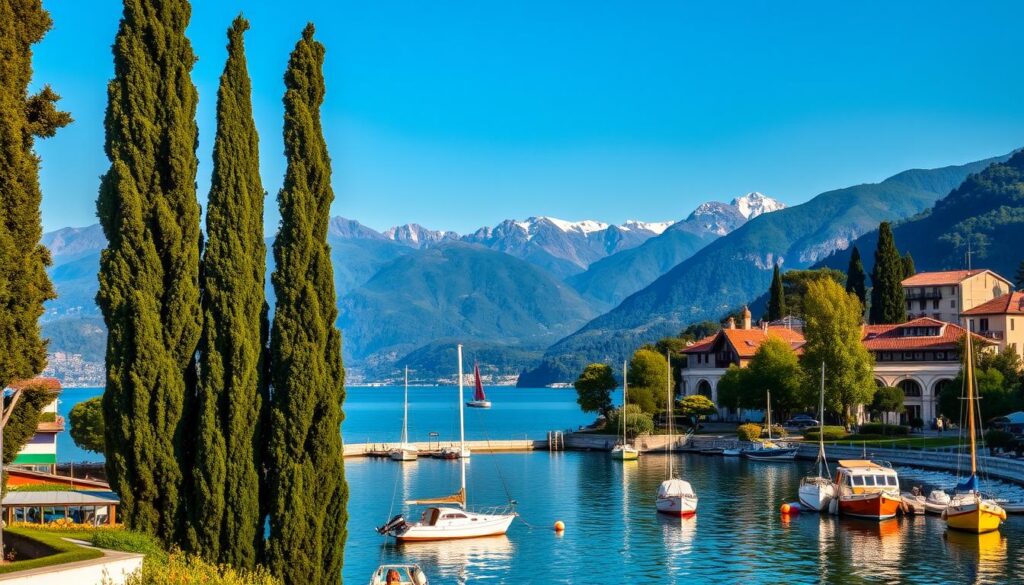
Skip Como’s celebrity scene. Garda’s agriturismos—like home if your nonna owned a lemon grove—offer pasta-making classes in Lazise. My favorite? Kneading tortellini while the sun sets over Bardolino’s vineyards.
Fuel your adventures with Sardine di Lago, pan-fried perch so fresh it practically jumps onto your fork. Pair it with Lugana wine—crisp as Garda’s morning air. The way to eat? Slowly, preferably under a pergola tangled with grapevines.
Balance lazy picnics with active discoveries. E-bike the Ciclabile dei Sogni path, where cliffs plunge into turquoise water. Or tour in a vintage Fiat 500, stopping to swim in Malcesine’s hidden coves.
Don’t miss Parco Giardino Sigurtà in spring. Tulips explode like fireworks across 150 acres—nature’s answer to Disneyland. Pro tip: Visit midweek when the only crowds are bees drunk on pollen.
Soaking in Turkey’s Pamukkale Hot Springs
Turkey’s Pamukkale isn’t just a destination; it’s a natural wonder that defies logic. The terraces, nicknamed “Cotton Castle,” gleam like frozen waterfalls under the sun. Walking barefoot on these mineral-rich pools feels like treading on warm marble—a UNESCO-listed miracle formed over millennia.
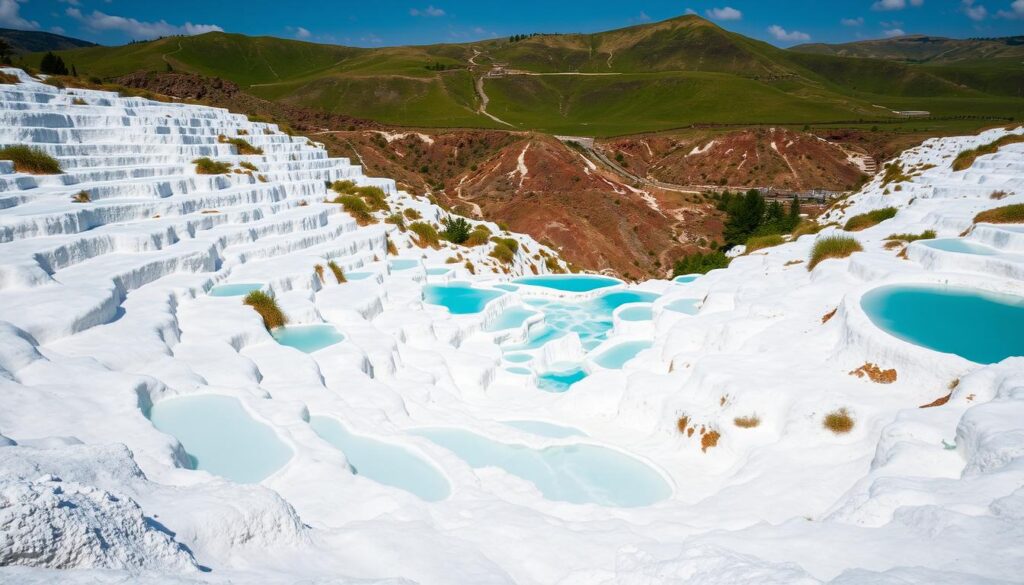
The Surreal White Terraces
Dawn is the golden hour here. Beat the crowds and watch steam rise off the travertines as the sky turns peach. Pro tip: Pack a GoPro (drones are banned) to capture the water’s glassy reflections. After a soak, explore Hierapolis’s ruins—ancient Romans knew a good spa day when they saw one.
Beachside Bliss in Fethiye
Two hours south, Fethize swaps thermal springs for turquoise coves. At Hillside Beach Club, pine trees frame private beach cabanas. Try stand-up paddleboarding in the Blue Lagoon or hike a stretch of the Lycian Way. Reward yourself with a mud mask ritual—this region thrives on indulgence.
For a quirky stay, Joy Saklikent’s treehouses dangle over a river canyon. Pair it with a detour to Ephesus and Sirince’s wine villages. Visit in summer for lazy afternoons, but spring and fall offer quieter magic.
Island Hopping Through Greece’s Hidden Gems
Somewhere between Sifnos’ clay pot stews and Milos’ moonlit beaches, I realized Greek island hopping isn’t a trip—it’s a rite of passage. Forget Mykonos’ DJ parties; these underrated destinations trade crowds for crusty bread dipped in chickpea broth.
Ferry or charter? Blue Star Ferries’ economy seats (€40) beat speedboats’ seasickness with sunset views. But splurge on a private yacht if you want to skinny-dip near Polyaigos’ uninhabited coves.
Amorgos stole my heart with its goat trails leading to cliffside monasteries. Stay at the Anemomilos Apartments—their terraces overlook the Aegean like a postcard that forgot to fade.
Santorini’s secret? Skip Oia’s selfie sticks for Pyrgos’ wine routes. Santo Wines’ Assyrtiko tastes sharper when paired with volcanic island views. Pro tip: Their sunset tastings sell out faster than Mamma Mia! sequel tickets.
At Perivolas Hotel, the cave pool floats you toward the horizon like a very pampered cork. For dinner, Astypalaia’s Xora taverna serves lobster spaghetti so good, you’ll forgive the ferry ride there.
Pack light: Hydra’s donkey taxis charge by the kilo, and Sarakiniko Beach’s lunar landscape demands impromptu photoshoots. Just don’t forget the reef-safe sunscreen—that Greek sun plays for keeps.
Living La Dolce Vita at Le Sirenuse, Positano
Le Sirenuse isn’t just a hotel; it’s a love letter to la dolce vita, penned in champagne and sea spray. Owned by the Sersale family since 1951, this pink-hued paradise lures you with mosaic terraces and truffle ravioli so rich, you’ll plot ceramic thefts just to stay longer.
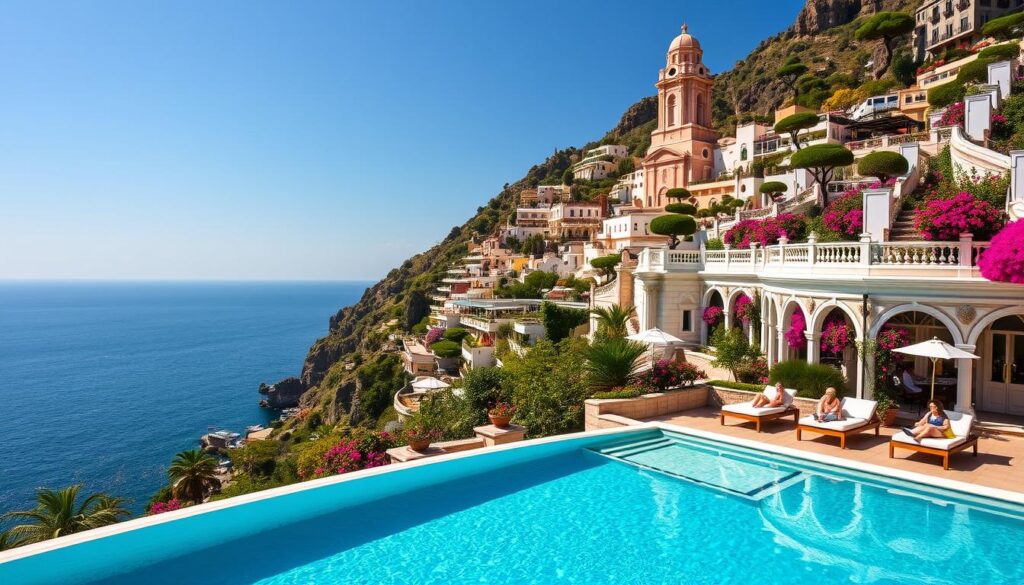
Room booking tip: Spring for a Sea View Superior—suites are lavish, but the view from these balconies (paired with breakfast delivered on silver trays) is the real inspiration. Prefer poolside glam? Il San Pietro’s daypass lets you sip Aperol where Steinbeck once scribbled notes for Harper’s Bazaar.
Positano’s shops are lethal. Antica Sartoria’s linen dresses and Ceramica Assunta’s hand-painted tiles will haunt your dreams. For photos, sneak to the villa’s lower terraces at golden hour—no crowds, just cliffs tumbling into the Tyrrhenian Sea.
Fuel up for the Path of the Gods hike with Nonna Sofi’s lemon cake. The trail demands sturdy shoes (and a stop at Buca di Bacco for post-hike spaghetti). Trust me: by sunset, you’ll be drunk on products of the land—limoncello, sea salt, and that irreplaceable Amalfi glow.
Road Tripping Ireland’s Wild Atlantic Way
Ireland’s Wild Atlantic Way isn’t just a road—it’s a 1,500-mile love letter to rugged coastlines. I followed travel writer Sophie Knight’s route, from Kinsale’s foodie haunts to Achill Island’s empty beaches. Each bend revealed something wilder: a castle crumbling into the sea, a pub where fiddles outnumber chairs.
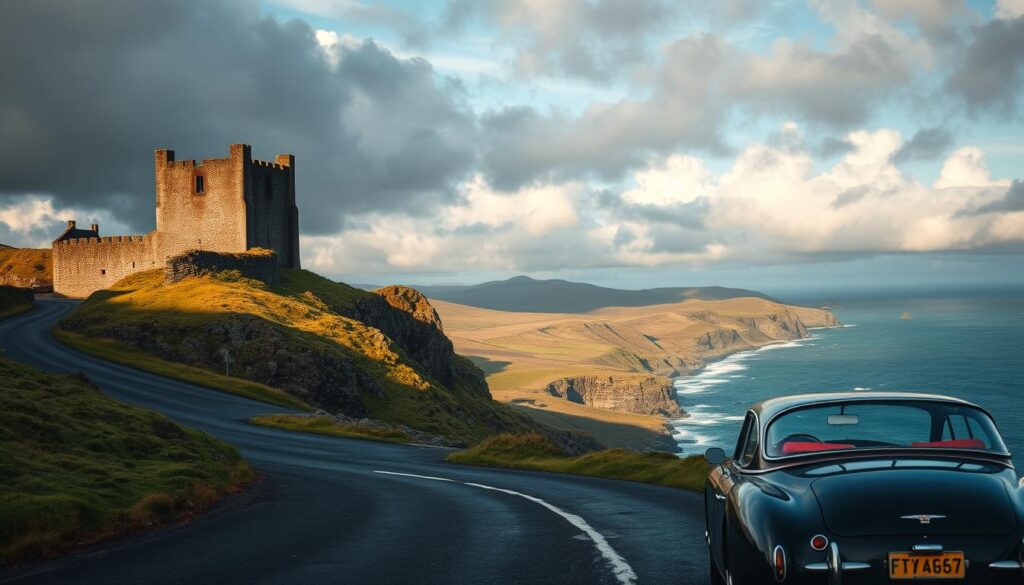
Cliffs, Castles, and Guinness Stops
Rental cars here play hard to get—automatic transmissions are rarer than sunny days. Book early through Discover Cars and opt for full coverage. Trust me, sheep have zero respect for right-of-way.
At the Cliffs of Moher, light transforms the landscape. Dawn paints the rocks gold, while sunset silhouettes puffins diving into the waves. For crowd-free shots, hike to Hag’s Head at sunrise.
| Sunrise | Sunset | |
|---|---|---|
| Crowds | Minimal | Peak |
| Lighting | Soft gold | Dramatic shadows |
| Photography Tip | Use a polarizing filter | Focus on silhouettes |
Detour to Skellig Michael if you’ve ever dreamed of being a Jedi. The boat ride is choppy, but the 6th-century monastery perched on a sea stack? Pure Star Wars magic.
- Pub strategy: Hit Killarney’s trad sessions by 9 PM—musicians vanish after midnight.
- City bookends: Dublin’s Little Museum packs a century of history into tiny rooms. Belfast’s Titanic Quarter? A sobering contrast.
- Fuel stops: Kinsale’s Fishy Fishy Café serves chowder so thick, your spoon might stand upright.
This country rewards slow exploration. Whether you’re sipping Guinness in Doolin or tracing Giant’s Causeway’s hexagonal myths, the way west feels like coming home.
Chasing the Northern Lights in Norway
Nothing prepares you for the moment green ribbons of light twist across the Arctic sky. Norway’s Northern Lights aren’t just a sight—they’re a full-body experience. I learned this shivering in Tromsø, where the auroras paint the darkness like a cosmic Etch A Sketch.
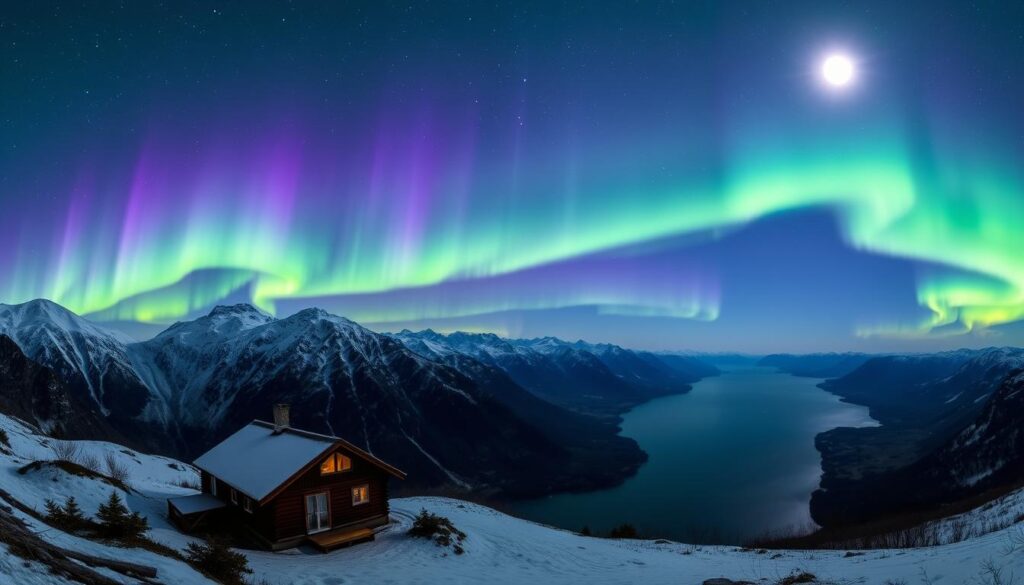
Timing is everything. September and March offer the sweet spot: equinox magic with fewer winter storms. Here’s how they compare:
| September | March | |
|---|---|---|
| Weather | Milder (20°F) | Snowier (5°F) |
| Daylight | 12+ hours | Increasing light |
| Pro Tip | Hike Lofoten’s peaks | Dog-sled under auroras |
Skip generic bus tours. Book a Sami-led reindeer sled or an electric snowmobile chase—both cut through the silence like a knife through ice. My guide from Polar Adventures knew every cloud gap like a bartender knows regulars.
Pair Tromsø with Oslo for contrast. The Munch Museum’s Scream feels tame after nature’s light show. Refuel at Vulkanfisk with whale carpaccio (controversial but unforgettable).
For the ultimate stay, Svartisen’s glass cabins dangle over glaciers. Pro tip: Set your camera to manual (15-second exposure) and pack brunost cheese—its caramel tang beats gas station snacks at 2 AM.
Norway’s auroras don’t just dazzle; they rewrite your definition of wonder. Just don’t forget mittens.
Coastal Drives Along Italy’s Amalfi Coast
Driving Italy’s Amalfi Coast is equal parts adrenaline rush and open-air museum. The SS163 road clings to cliffs like a stubborn barnacle, delivering heart-stopping views between hairpin turns sharp enough to fold origami cranes.
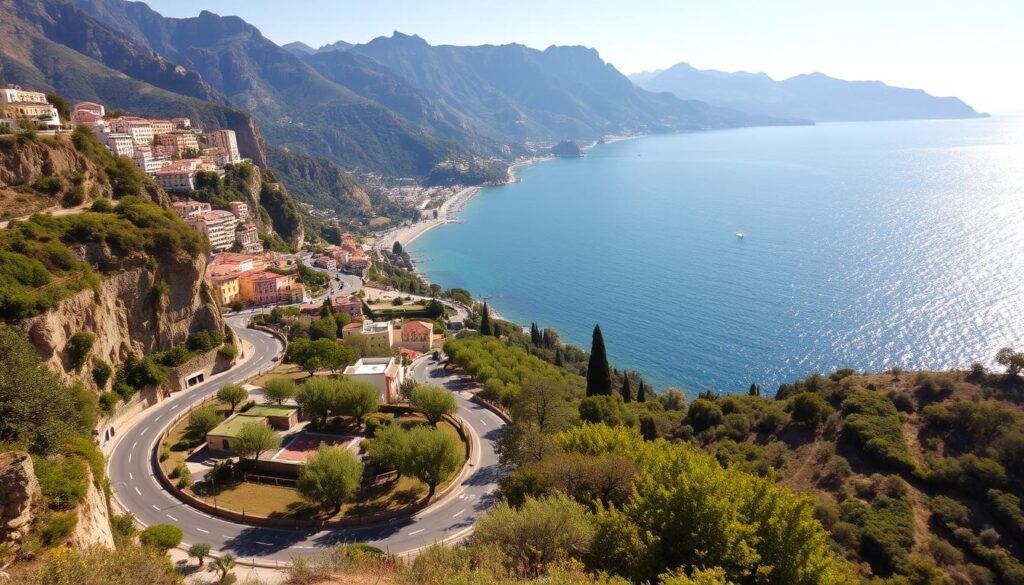
- ZTL zones (Limited Traffic Areas) will ticket unauthorized cars faster than you can say “scusi”
- Rent the smallest car available—Fiats 500 are local heroes for a reason
- Morning drives beat tour bus gridlock after 10 AM
“The road dances with the land—you must let it lead.”
| Route | Distance | Best For |
|---|---|---|
| SS163 Coast Road | 50km | Classic cliffside vistas |
| SS366 Panoramica | 35km | Quicker, inland alternative |
| Boscoreale Detour | 12km | Ancient Roman villas |
At Lo Scoglio, their seafood towers arrive stacked higher than Positano’s staircases. Time your lunch for the golden hour—the sun transforms the Tyrrhenian Sea into liquid mercury.
Ravello’s Villa Cimbrone gardens float above the coast like a cloud kingdom. The Terrace of Infinity lives up to its name—one glance at the 1,000-foot drop will reset your pulse.
Vietri sul Mare’s ceramic shops are lethal to wallets. For shipping inspiration, Ceramica Artistica Solimene packs fragile pieces with the care of Venetian glassblowers. Pro tip: Their cobalt blue tiles make better souvenirs than another Positano linen dress.
This drive doesn’t just show you Italy—it makes you earn every breathtaking curve.
Exploring Croatia’s Secret Islands
Croatia’s islands don’t just wink at you from postcards—they pull you into their rhythm like a Dalmatian folk song. I spent weeks exploring these Adriatic gems, where ancient stone towns crumble into the water and pine forests scent the air. Whether you’re dancing barefoot at Hvar’s beach clubs or snorkeling Lošinj’s silent coves, each island offers a different flavor of escape.
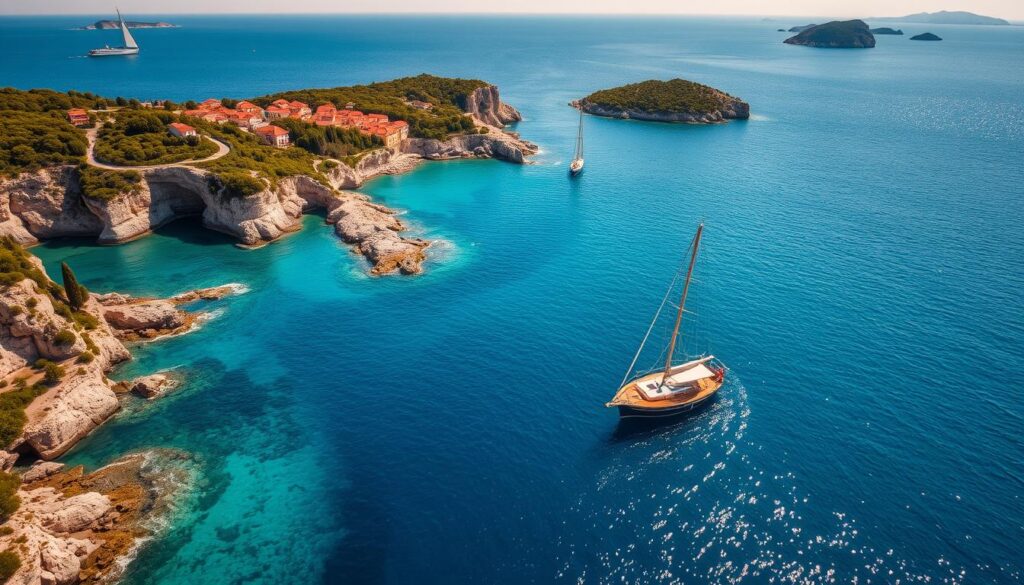
Hvar’s Beach Clubs and History
Hvar is a masterclass in contrasts—where 15th-century fortress walls loom over DJ sets at Carpe Diem Beach. Climb to the Spanish Fortress for sunset views that’ll make your Instagram followers weep. Then, join the after-dark parties where cocktails cost less than a museum ticket.
Don’t miss the Blue Lagoon Donkeys. These fuzzy locals accept apple peels as currency for photo ops. For a deeper dive, book a tour of Stari Grad’s lavender fields. The scent clings to your clothes like a happy memory.
Lošinj’s Untouched Coves
Lošinj trades crowds for serenity. Its beaches are hidden behind pine trails, and the water is so clear, you’ll spot starfish from the shore. Dive the Apollo statue site—a 2nd-century bronze god lounges 15 meters down, surrounded by bream fish.
Eco-warriors will love Cres’ griffon vulture sanctuary. These winged giants have 8-foot wingspans and zero interest in your picnic.
- Ferry vs. yacht: Jadrolinija ferries cost €20, but a private charter (€500/day) lets you skinny-dip at Šolta’s olive grove coves.
- Local flavor: Pair Pag’s sheep-milk cheese with rakija—it’s like a lactose-intolerant person’s dare.
- Underwater gem: The Apollo statue dive site is Croatia’s answer to Atlantis.
This experience isn’t about ticking boxes. It’s about losing track of time between salt-crusted bread and sunburned shoulders. Just don’t forget the reef-safe sunscreen—the Adriatic sun plays for keeps.
Iceland’s Westfjords: Where Wilderness Reigns
The Westfjords aren’t a destination; they’re an expedition into Earth’s last untamed edges. Here, roads crumble into fjords, and Arctic foxes rule the tundra. I followed explorer Charley Ward’s route—chasing waterfalls, red sand beaches, and the elusive experience of true isolation.
Dynjandi waterfall is the region’s crown jewel. Its 330-foot cascade splits into seven tiers, like a wedding cake made of water and thunder. Hike to the top for mist-soaked views worth the slippery climb.
Rauðasandur beach breaks Iceland’s black-sand mold. At sunset, its rosy grains glow like embers. Time your visit for low tide to spot seals bobbing in the waves.
Road Trip Survival Guide
F-roads here don’t mess around. Rent a 4×4 or risk becoming a cautionary tale. Key routes:
| Road | Challenge Level | Reward |
|---|---|---|
| Route 60 | Moderate (gravel) | Dynjandi access |
| Route 622 | Expert (unpaved) | Hornstrandir trailhead |
| Rauðasandur Access | Easy (paved) | Seal-spotting coves |
Hot springs are the ice-breaker of choice. Drangsnes’ free pools edge the fjord—perfect for aurora gazing. Reykjanes’ secluded springs require a hike but offer volcanic mud soaks.
- Stay wild: Heydalur Farm’s guesthouse pairs sheep sheds with geothermal pools. Their homemade skyr breakfast could convert a carnivore.
- Taste test: Fermented shark at Tjöruhúsið comes with a schnapps chaser. Pro tip: Plug your nose and chew fast.
- Photo hack: Capture Rauðasandur’s red sand against black cliffs at golden hour. The contrast looks Photoshopped—but it’s all nature.
At Látrabjarg cliffs, puffins dive-bomb like drunk kites. This world-class bird sanctuary hosts 40% of Earth’s razorbill population. Just watch your step—the drop is 1,400 feet.
“In the Westfjords, you don’t find adventure. It finds you—usually when you’re knee-deep in a sheep trail.”
Pack your sense of humor and waterproof everything. This is Iceland raw, unfiltered, and utterly unforgettable.
How to Prioritize Your Europe Bucket List
The real challenge isn’t choosing destinations—it’s deciding what to skip. After a decade of testing strategies, here’s my battle-tested way to craft an itinerary that balances iconic sights and secret finds.
Pick Your Passion
Thematic trips help narrow options. Foodies might chase chocolate workshops in Bruges and truffle hunts in Umbria. History buffs? Start with Nuremberg’s trials museum and Tallinn’s medieval walls.
Nature lovers should plot road trips through Scotland’s Highlands or Albania’s Riviera. Pro tip: Layer themes—pair Lisbon’s pastéis de nata with day trips to Sintra’s castles.
Seasonal Chessboard
Timing transforms experiences. Iceland in winter means auroras and ice caves, while summer unlocks midnight sun hikes. Use this cheat sheet:
| Season | Sweet Spots | Skip If… |
|---|---|---|
| Spring | Stockholm’s cherry blossoms, Montenegro trails | You hate rain |
| Summer | Croatian island hopping, Swiss alpine lakes | Crowds trigger you |
| Fall | French vineyards, Bavarian castles | You need beach weather |
Budget Ninja Moves
Shoulder seasons (April-May, September-October) slash prices by 30%. Swap Santorini for Paros, or Lake Como for Garda. I once booked a Tuscan villa in November for less than a Paris hostel.
“Travel isn’t about seeing everything—it’s about seeing what matters to you.”
Family-Proof Planning
Multi-gen trips need layered appeal. Bruges works because grandparents love canals, parents adore beer tours, and kids go wild for chocolate museums. Tallinn’s old town has fairy-tale towers plus secret KGB bunkers.
Tech Trick
Google My Maps lets you layer food spots, hikes, and hotels. My Croatia map color-coded:
- Blue pins: Seafood joints like Pelegrini’s in Šibenik
- Green pins: Plitvice Lakes’ secret entry points
- Red pins: Last-minute ferry routes
Remember: A trip should thrill, not exhaust. Start with three non-negotiables, then build around them. That’s how bucket list dreams become stamped passports.
When to Visit Each Destination
Ever arrived somewhere amazing…only to realize you picked the worst possible week? Timing transforms good trips into legendary ones. Here’s how to outsmart crowds and catch destinations at their peak.
Crowd chess: Venice in February means foggy canals and €3 espressos. Come June, you’ll pay €12 for the same coffee while dodging cruise ship groups. For Paris, winter offers empty Louvre corridors—just pack thermals.
Portugal’s sweet spot? April and October. The sun warms Lisbon’s tiles without scorching them, and Douro Valley’s vineyards blush gold. I once had Sintra’s Pena Palace all to myself on an October Tuesday.
| Event | When | Pro Tip |
|---|---|---|
| Laver Cup (Geneva) | September | Book hotels 6 months early |
| Pamplona Running | July 6-14 | Stay in nearby Tudela |
| Norway’s Auroras | November-March | Base in Tromsø, not Oslo |
Amalfi’s microclimates play tricks. May brings lemon-scented breezes perfect for coastal drives. September cranks up the heat—great for swimming, brutal for uphill climbs to Ravello.
- August warning: Many Italians flee cities. You’ll find Rome’s best restaurants shuttered but beaches packed.
- Winter magic: Croatia’s islands go dormant—perfect for writers craving solitude.
- Spring bonus: Netherlands’ tulip fields peak mid-April. Go weekdays to avoid flower selfie wars.
“Travel timing isn’t about good or bad seasons—it’s about matching your priorities to the destination’s rhythm.”
For sailing Croatia, July’s meltemi winds create ideal conditions. Just know Hvar’s harbor becomes a yacht parking lot. Prefer quiet days? Try Vis Island in June—their asparagus festival beats any club scene.
Remember: There’s no bad time, just wrong expectations. I’ll take Iceland’s February blizzards over summer tour buses any day—provided I’ve got my heated socks.
Budget Tips for Crossing Off Your List
Smart travelers know the secret: adventure and affordability aren’t mutually exclusive. With the right hacks, you can stretch your budget further without missing out on epic experiences. Here’s how I do it.
Transport Hacks
Skip pricey flights. Sleeper trains like Austria’s Nightjet offer beds for €50—you’ll save on a hotel and wake up in a new city. For multi-country trips, compare Interrail passes to point-to-point tickets. Pro tip: Off-peak fares can slash costs by 40%.
Accommodation Tiers
Think beyond hotels. Italy’s monastery stays (€30/night) include breakfast and fresco views. Prefer privacy? Try house swaps through platforms like HomeExchange. My best deal: a Paris loft for watering a cactus twice.
- Budget-friendly picks: Hostels with private rooms (Berlin’s Pfefferbett has rooftop bars).
- Splurge-worthy: Farm stays in Tuscany—vineyard tours included.
Meal Savings
Eat like a local. Lisbon’s Time Out Market serves gourmet petiscos (small plates) for €5. In Rome, grab pizza al taglio for lunch, then splurge on dinner at Trattoria Da Enzo. Bonus: Wine costs less than soda in Croatia’s konobas.
| City Pass | Worth It? | Hack |
|---|---|---|
| Paris Museum Pass | Yes (if you visit 3+ sites) | Skip Louvre’s line—enter via Carrousel. |
| Berlin WelcomeCard | No | Buy transit tickets separately. |
“Points are the currency of savvy travelers—collect them like seashells.”
Points Strategy
Stack rewards. The Chase Sapphire Preferred card earns 3x on dining—perfect for Italy’s trattorias. Transfer points to airlines like Air France for last-minute deals. I once flew NYC-to-Rome for 30,000 miles.
Remember: Fewer days can mean more value. A midweek Venice visit avoids weekend markups, and shoulder seasons (April/October) unlock luxury at hostel prices. That’s the way to travel rich on a ramen budget.
Why Revisiting Europe Might Top Your List
Some places whisper for a second visit before you’ve even left. My first Roman holiday raced through the Forum. Years later, I spent three time-warped days tracing Caravaggio’s footsteps in hidden chapels—proof that deeper dives beat checklist tourism.
Seasonal contrasts reveal new personalities. The Swiss Alps trade winter’s ski runs for summer’s wildflower hikes. Here’s how they compare:
| Winter | Summer | |
|---|---|---|
| Activity | Downhill skiing | Paragliding |
| Crowds | Peak (Dec-Feb) | Moderate (Jun-Aug) |
| Pro Tip | Stay in Wengen | Book via Swiss Travel Pass |
Niche interests flourish on return trips. Dublin’s literary pub crawl hits different when you’ve read Ulysses twice. WWII buffs can swap Normandy beaches for Berlin’s lesser-known Topography of Terror.
“A city’s soul hides in its second stories—literally. Rome’s Palazzo Valentini reveals underground villas most tourists miss.”
Personal growth reshapes destinations. Iceland solo at 25 meant hostel parties. At 35? Soaking in the Blue Lagoon with my toddler, who mistook geothermal steam for dragon breath.
Barcelona’s Gràcia district proves hidden layers trump guidebook highlights. Its plazas host August’s Festa Major—where papier-mâché giants parade past world-class tapas bars unknown to Gothic Quarter crowds.
Your bucket list isn’t a one-and-done. It’s a living thing, growing richer with each return. Because the best experience? It’s often the one you didn’t know to look for the first time.
Conclusion
Travel isn’t about ticking boxes—it’s about collecting moments that stick to your ribs. Whether sipping port in Porto’s cobbled alleys or clinking champagne on the Orient-Express, my bucket list thrives on contrasts. Blend iconic stops with personal quirks: pair Rome’s Colosseum with a midnight pasta crawl, or offset Swiss hikes with molten cheese therapy.
Our world shifts faster than ever—glaciers retreat, coastlines evolve. Visit places that whisper to you now, not just those trending on Instagram. Leave pages blank in your journal for return trips; the best experience often hides in the second look.
Now, your turn. What’s your #1 revisit pick? A hidden Greek taverna? A Norwegian fjord that stole your breath? Share your travel inspiration—let’s keep the adventure going.

